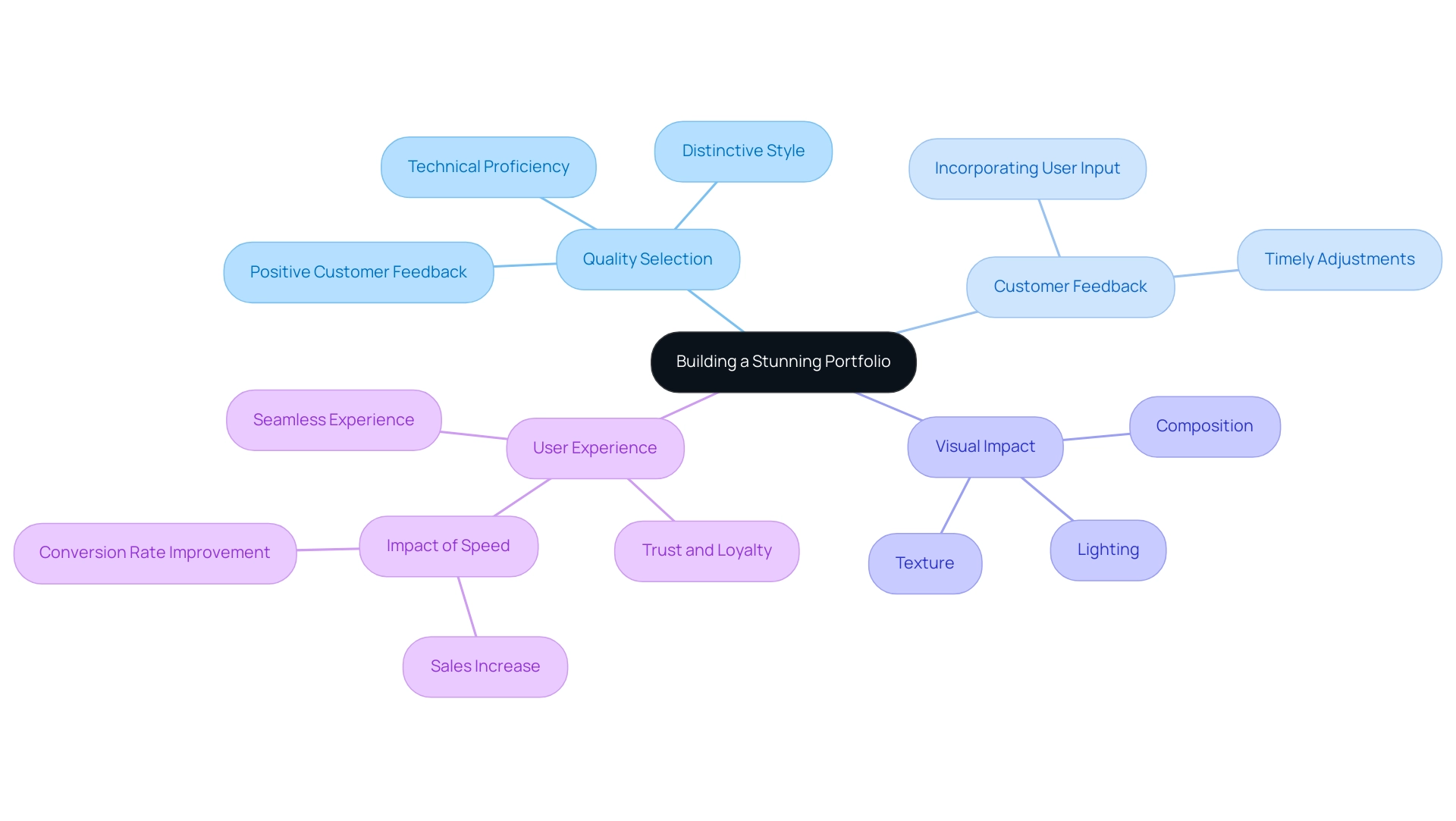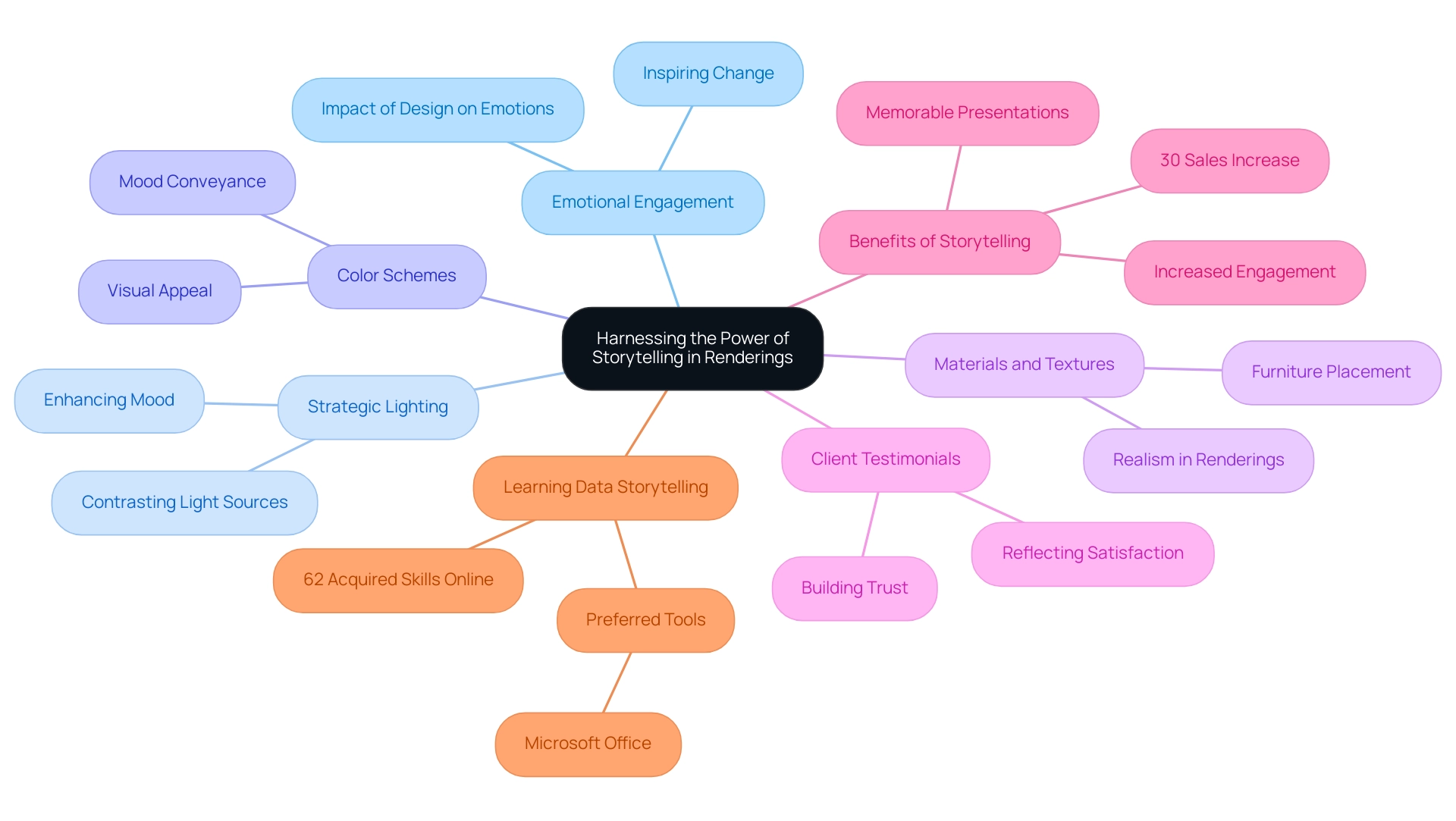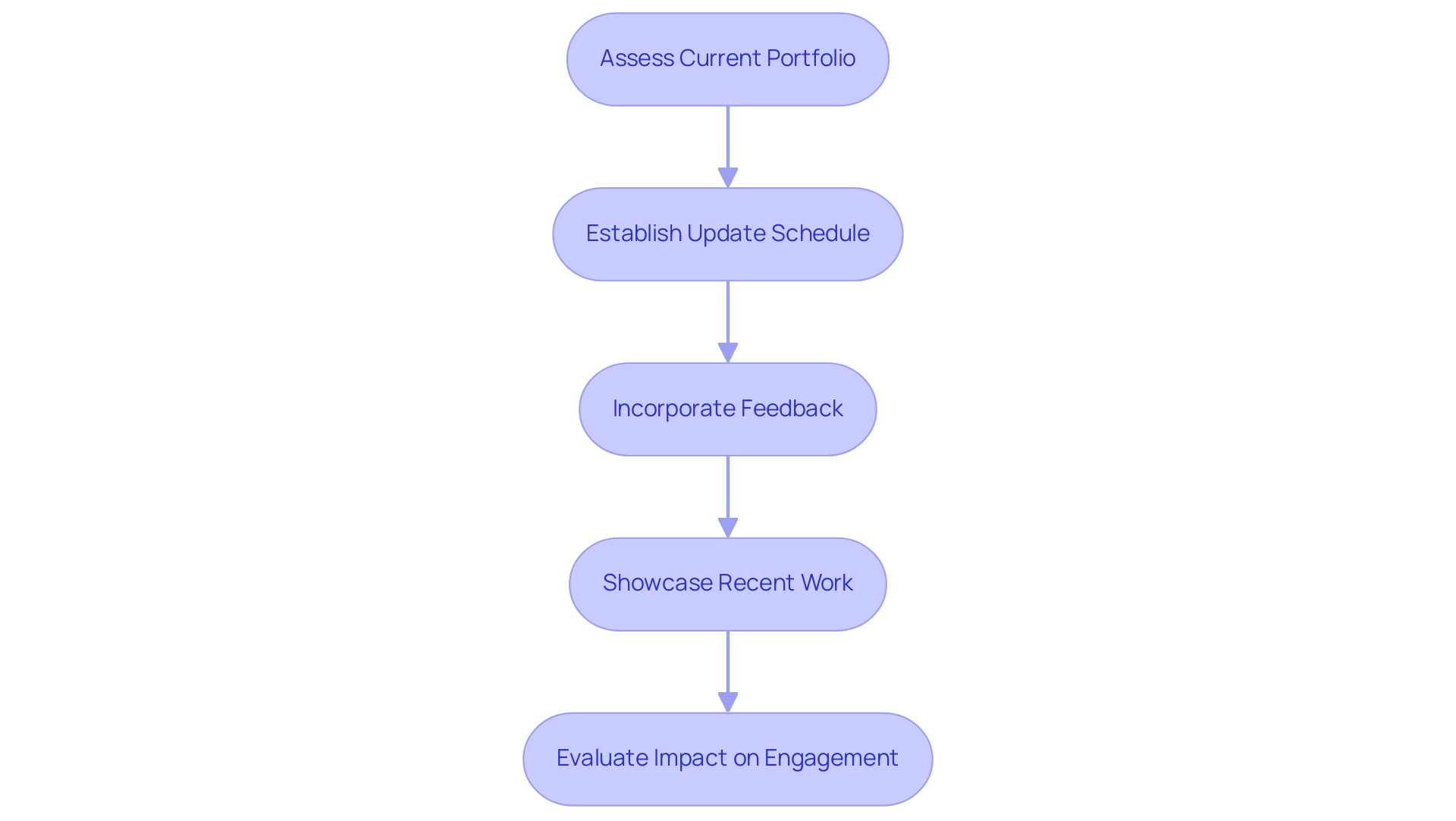Overview:
To build a stunning portfolio with high-quality 3D renderings, it is essential to select your best work that showcases technical proficiency and a unique architectural style, while also incorporating diverse projects to demonstrate adaptability. The article emphasizes that a well-curated collection, along with high-quality renderings and effective storytelling, not only enhances visual appeal but also fosters trust and engagement with prospective clients, ultimately establishing the architect as a leader in the design sector.
Introduction
Creating a compelling architectural portfolio is fundamental for professionals seeking to establish their expertise and attract potential clients. The process begins with a discerning selection of past projects that not only highlight technical skills but also reflect an architect’s unique style and vision.
By prioritizing quality over quantity and incorporating diverse project types, architects can craft a narrative that resonates with a wide audience. High-quality renderings play a critical role in this endeavor, serving as a visual testament to an architect’s capabilities.
Furthermore, the integration of storytelling techniques enhances the emotional connection with viewers, making the portfolio not just a collection of works, but a powerful tool for engagement. Regular updates ensure that the portfolio remains relevant in a rapidly evolving industry.
This article delves into the essential elements of an impactful architectural portfolio, offering insights into:
- Project selection
- Rendering quality
- The significance of narrative in showcasing architectural prowess
Selecting Your Best Work: The Foundation of a Stunning Portfolio
To understand how to build portfolios with high-quality 3D renderings, begin by meticulously reviewing all completed projects, selecting those that not only demonstrate your technical proficiency but also embody your distinctive architectural style. Prioritize tasks that received positive feedback from customers and peers, as this validation speaks volumes about your capabilities and the exceptional professionalism exhibited by your team. For instance, one customer remarked, ‘The attention to detail and responsiveness to our feedback made all the difference in the final outcome.’
Each selected piece should possess a strong visual impact, emphasizing key elements such as lighting, texture, and composition. It is essential to display a varied selection of works that represent different aspects of your skills, especially those where feedback from users had a significant impact in improving the final outputs, enhancing both functionality and aesthetics. As a guiding principle, remember that quality supersedes quantity; a carefully curated selection of exceptional works is far more compelling than an extensive compilation of lesser-quality projects.
This strategic method not only improves the visual attractiveness of your collection but also cultivates trust and loyalty among prospective customers. In fact, studies show that every 0.1-second improvement in speed on your web page can lead to increased sales, views, average order value, and conversion rates, highlighting the importance of a seamless user experience in your presentation. Furthermore, as mentioned in a case study titled ‘Building Trust and Loyalty through UX Strategy,’ investing in a thoughtful UX strategy is essential for fostering trust and enduring relationships with customers.
Ultimately, understanding how to build portfolios with high-quality 3D renderings is vital in establishing yourself as a leader in the design sector, demonstrating a commitment to customer satisfaction and the significance of testimonials in highlighting your dedication to excellence. By actively involving customers in the rendering process and making timely adjustments based on their feedback, you not only enhance the quality of your work but also build a collaborative relationship that leads to greater satisfaction.
The Role of High-Quality Renderings in Portfolio Success
Investing in high-quality rendering software is essential for lead architects aiming to excel in visualization. Advanced techniques such as realistic lighting, precise material representation, and intricate textures form the backbone of impactful renderings, greatly enhancing visualization and improving decision-making. Prominent tools such as V-Ray and Corona Renderer excel in the market for their capacity to generate remarkably realistic outcomes, which not only enhances the quality of the work but also promotes customer satisfaction by precisely capturing the essence of design.
Furthermore, ensuring that renderings are optimized for diverse platforms—be it for print or digital presentation—is essential for maintaining visual integrity across various formats. This meticulous attention to detail significantly contributes to:
- Building portfolios with high-quality 3D renderings, showcasing projects in their best light to prospective customers while facilitating effective communication among architects, customers, and contractors.
- Investing in 3D and VR technologies, providing a competitive advantage in real estate marketing, allowing architects to effectively convey their visions and enhance client engagement.
As Brazilian designer Fábio Rakauskas noted, ‘I created models of 14 critical historical buildings to preserve an accurate record of their renovation history,’ underscoring the importance of precise representation in visualization. This commitment to quality and detail is vital for building a successful collection, achieving cost savings through early detection of potential issues, and learning how to build portfolios with high-quality 3D renderings as powerful marketing tools to attract stakeholders and investors.
Showcasing Versatility: Including a Range of Projects
Integrating a varied collection of works into your design compilation is crucial for showcasing adaptability and skill. Projects should encompass categories like residential, commercial, and public spaces, reflecting a comprehensive understanding of various architectural styles and user requirements. This variety not only showcases your adaptability but also aligns with findings indicating that over 85% of businesses recognize that robust design significantly enhances brand recall among consumers.
This statistic highlights the significance of varied initiatives in improving a collection’s effectiveness. To enable smooth navigation for prospective customers, think about organizing your endeavors efficiently—whether by category or design method. Incorporating brief explanations that outline your particular role and the difficulties faced in each endeavor can further enhance your narrative.
As Jimena Gamio, a staff graphic designer, notes, ‘These conversations might be uncomfortable at times, but they open people’s perspectives.’ This emphasizes the significance of varied viewpoints in design projects, which can result in creative solutions and enhanced customer involvement. An illustrative example is the Hip Hop Architecture Camp, founded by Michael Ford, which engages youth through architecture viewed through the lens of hip hop culture, providing unique access to design education for diverse groups.
Furthermore, learning how to build portfolios with high-quality 3D renderings can transform architectural narratives, enhancing emotional impact and demonstrating design intent. The iterative design phase, characterized by collaborative feedback and adjustments, plays a pivotal role in accurately reflecting your vision and ensuring client satisfaction. This process starts with initial communication and a brief to understand your goals and requirements.
Following this, our team creates initial renderings based on the gathered information, working closely with you to incorporate feedback and make necessary adjustments. Such initiatives exemplify the importance of showcasing project diversity and adaptability in your portfolio, reinforcing not only your design capabilities but also your commitment to social engagement. We invite you to reach out for a consultation to discuss how we can bring your design vision to life.
Harnessing the Power of Storytelling in Your Renderings
In the realm of architectural rendering, the narrative inherent in each space plays a pivotal role in viewer engagement. It is essential to consider not only the functional aspects of a space but also the emotions it is designed to evoke. By utilizing strategic lighting—contrasting artificial light with natural sunlight—and thoughtfully chosen color schemes, architects can effectively convey mood and atmosphere, enhancing the overall sensory experience.
The essential elements of interior renderings, including meticulous attention to materials, textures, and furniture placement, further strengthen the visualization of indoor spaces. Notably, detailed furniture models are crucial in enhancing realism and demonstrating how the space can be utilized effectively. Accompanying your renderings with well-crafted narratives that articulate the design intent and the client’s vision enriches the viewer’s experience.
This approach not only fosters a deeper connection with the audience but also significantly increases the memorability of your portfolio. As emphasized by recent insights, storytelling in marketing, including design presentations, is essential in establishing relationships and trust, ultimately resulting in actionable outcomes. A well-told story can inspire change and drive engagement, making it an indispensable tool in the arsenal of any lead architect.
Notably, campaigns utilizing storytelling have resulted in sales increases of up to 30%, showcasing its tangible benefits. Moreover, a significant 62% of professionals have acquired data storytelling skills through online courses, emphasizing the growing importance of these skills in the industry. The case study titled ‘Memorable and Influential Presentations’ illustrates how storytelling evokes emotions and sparks curiosity, leaving a lasting impact on the audience when data is presented in a narrative form.
Additionally, client testimonials serve as a vital component in establishing trust and reliability, reflecting the satisfaction of previous clients and enhancing the credibility of your architectural visualization efforts.
Keeping Your Portfolio Current: The Key to Ongoing Engagement
For lead architects, understanding how to Building portfolios with high-quality 3D renderings is indispensable for maintaining a relevant and engaging collection of work. Consistently examining and updating your collection is crucial for understanding how to Building portfolios with high-quality 3D renderings by adding new endeavors and eliminating obsolete work. Establishing a schedule for updates—ideally every six months—ensures that your portfolio, especially in how to Building portfolios with high-quality 3D renderings, accurately reflects your latest capabilities and the evolving design landscape.
This is especially important in the realm of architectural rendering, where a cooperative approach—starting with initial communication, briefs, and grasping your vision—plays a significant role in customer satisfaction. Engaging with feedback from peers and clients can provide valuable insights into areas for enhancement. Furthermore, showcasing recent works that incorporate innovative techniques or styles not only demonstrates your adaptability but also reinforces your commitment to excellence.
The strategic investment in quality 3D renderings demonstrates how to Building portfolios with high-quality 3D renderings, enhancing project appeal and approval while acting as a window into the future of your projects. Just as responsive design ensures that websites and applications adjust to optimal views on all devices, it is crucial for architects to reflect this adaptability in their work. Notably, statistics reveal that 56% of businesses have revised their design strategies for improved brand consistency in the last two years.
Furthermore, with 80.7% of surveyed companies indicating it takes about a month to design their websites, timely updates to collections become even more critical. The case study titled ‘Color Usage in the Digital Age’ illustrates how technology has transformed design aesthetics, showing a 250% increase in the use of color due to enhanced technology. This trend highlights the necessity for designers to keep their collections aligned with current practices.
By actively managing your portfolio and focusing on how to building portfolios with high-quality 3D renderings, you can significantly enhance client engagement and improve brand recall, as over 85% of businesses recognize the correlation between robust design and consumer recognition.
Conclusion
An effective architectural portfolio is built on essential elements that highlight an architect’s expertise and distinctive style. The careful selection of projects is paramount; by prioritizing quality over quantity, architects can showcase their most compelling work, fostering trust and loyalty among potential clients.
High-quality renderings are vital for enhancing visual appeal. Utilizing advanced rendering techniques allows architects to create lifelike visualizations that communicate design intent effectively, thereby improving client engagement and facilitating better communication among stakeholders.
Incorporating a diverse range of projects demonstrates versatility and a comprehensive understanding of various architectural styles and client needs. This diversity not only enhances brand recognition but also reflects a commitment to innovative solutions.
Additionally, integrating storytelling into the portfolio enriches the viewer’s experience, fostering emotional connections that increase memorability and client satisfaction.
Regular updates to the portfolio are crucial for maintaining relevance in a rapidly evolving industry. A proactive approach ensures that the work reflects current trends and techniques, reinforcing the architect’s dedication to excellence.
In summary, a compelling architectural portfolio is a strategic tool for effective engagement and communication. By focusing on project selection, rendering quality, diversity, storytelling, and ongoing updates, architects can effectively showcase their skills and attract potential clients in a competitive landscape.





0 Comments